CDC Science – Catalyst for Innovation
Since CDC’s beginnings as a scientific agency, innovation has been at its core, with CDC professionals inventing tools, procedures, and strategies to improve their own work and to assist other public health professionals. This portion of the exhibit highlights some of CDC’s most creative accomplishments of the 1950s, 1960s, and 1970s.
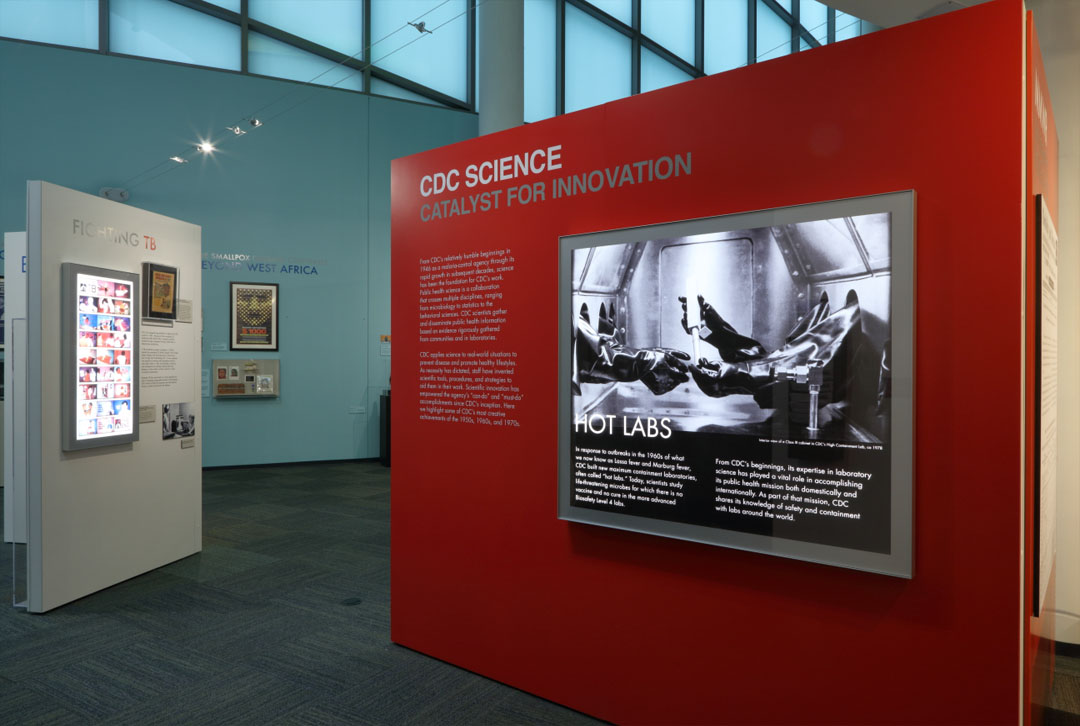
Hot Labs
CDC’s current reputation for gold standard laboratory excellence started in the 1960s. Outbreaks of what are now known as Lassa fever and Marburg fever created a demand for a safer lab environment for the scientists studying pathogens that cause these potentially fatal diseases. In response, CDC built new maximum containment laboratories. In an image shown here, CDC microbiologists investigate Marburg fever in what then was a state-of-the-art “hot lab,” also referred to as Biological Safety Cabinets or “box labs.” A box lab was typically a tall metal cabinet with glass windows and round, gloved entry portals. Some box labs also had microscopes. A pathogen being studied would remain inside the box, while the scientist was outside of it. The scientists manipulated the specimens by inserting their hands into the gloves attached to the portals.
Today, when scientists study life-threatening pathogens, they use the more advanced Bio Safety Level, or BSL labs. CDC continues its laboratory work in BSL 2, 3, and 4 labs. As part of CDC’s domestic and international public health mission, CDC shares safety and containment expertise with labs around the world.
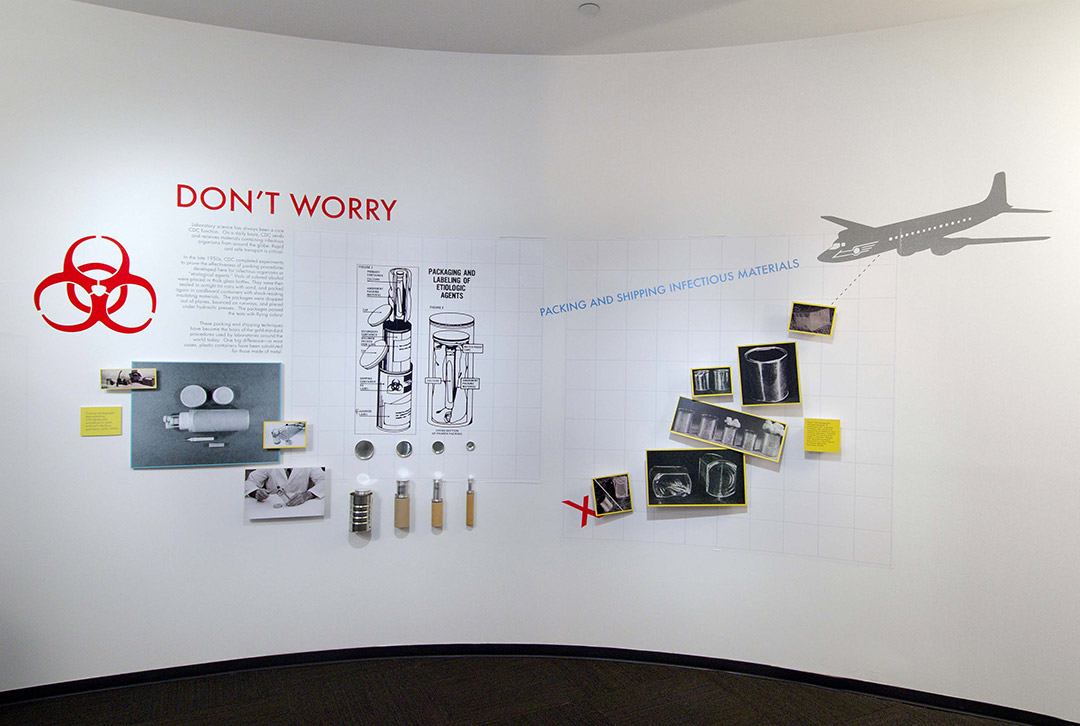
“Don’t Worry:” Packing and Shipping Infectious Materials
Every day, CDC receives and sends potentially infectious materials from around the world. The exhibit depicts the process used to select and test shipping containers. CDC labs receive specimens to aid other labs in the identification of pathogens and mail specimens to assist other laboratories in standards testing and training. The rapid and safe transportation of these materials is critical to assure safety for both laboratorians and mail carriers who handle the packages.
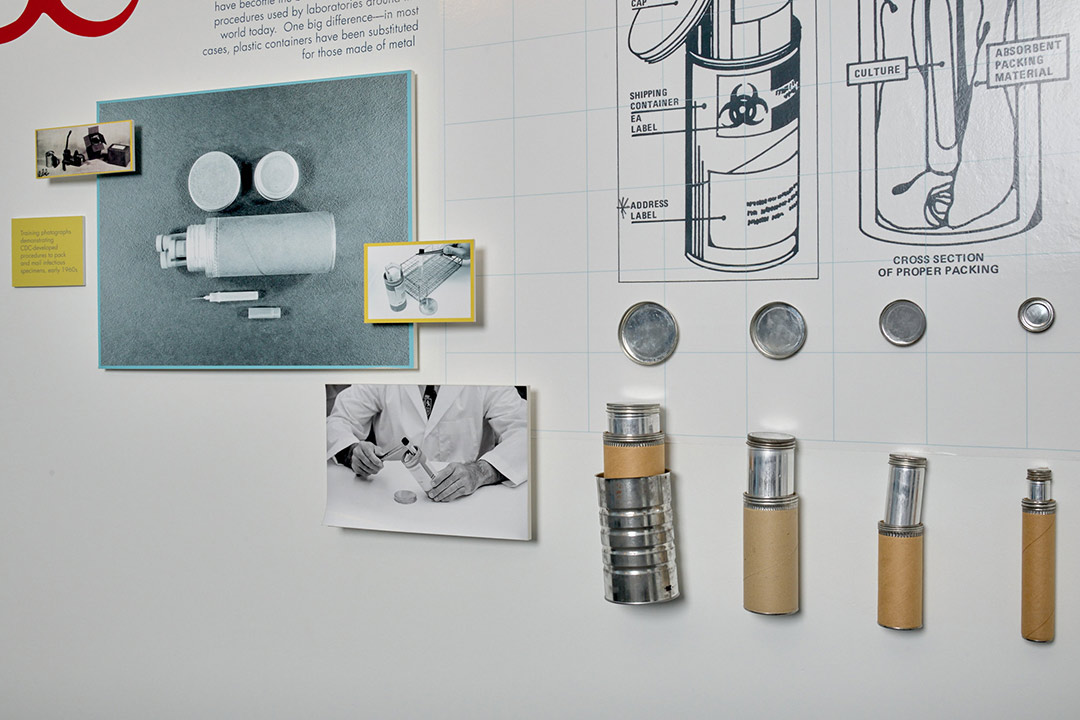
Layers of Protection
Shown here is packaging used to mail infectious materials and photographs from an informal experiment conducted in the late 1950s that tested the effectiveness of the packing procedures. To simulate infectious organisms, vials of colored alcohol were placed in thick glass bottles. The filled vials were nestled into other containers and then sealed in airtight tin cans which were first filled with sand and then packed in cardboard containers filled with shock-resisting, insulating materials.
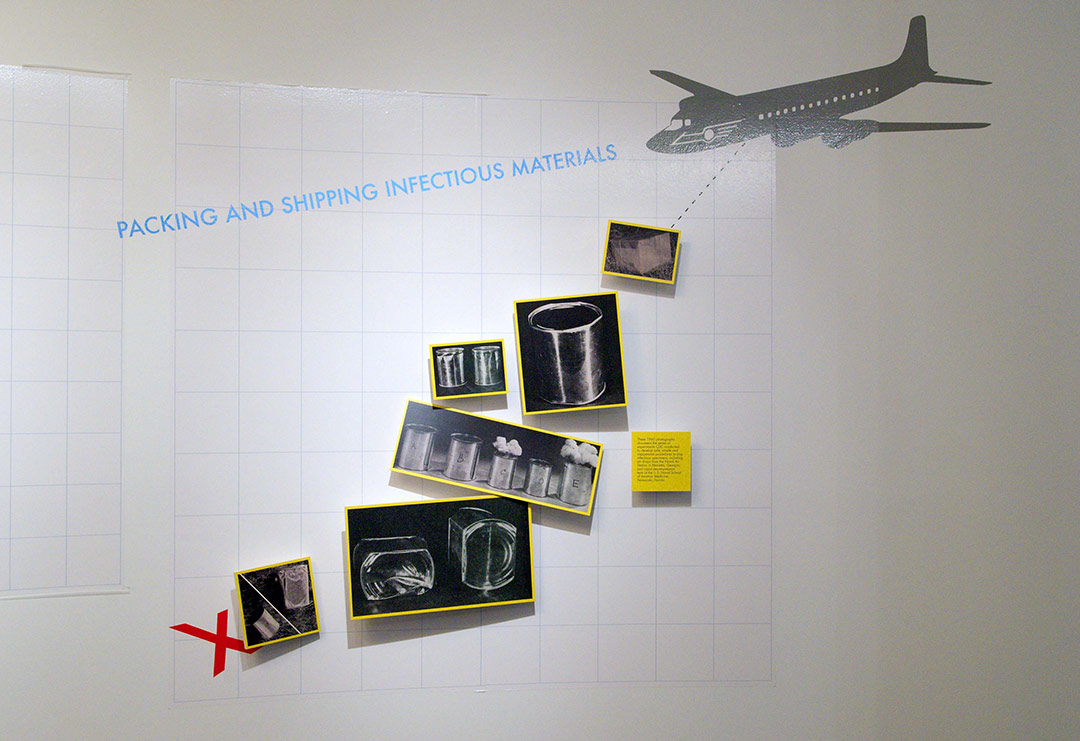
Testing Methods
The packages were tested by being dropped out of planes, bounced on runways, and placed under hydraulic presses. The photographs from the tests show that while some packages opened, the techniques withstood all tests and versions of this packaging remain in use today. CDC packaging methods are now the basis for laboratory gold-standard shipping, with one big update from the techniques tested in the 1950s: plastic containers have replaced glass vials.
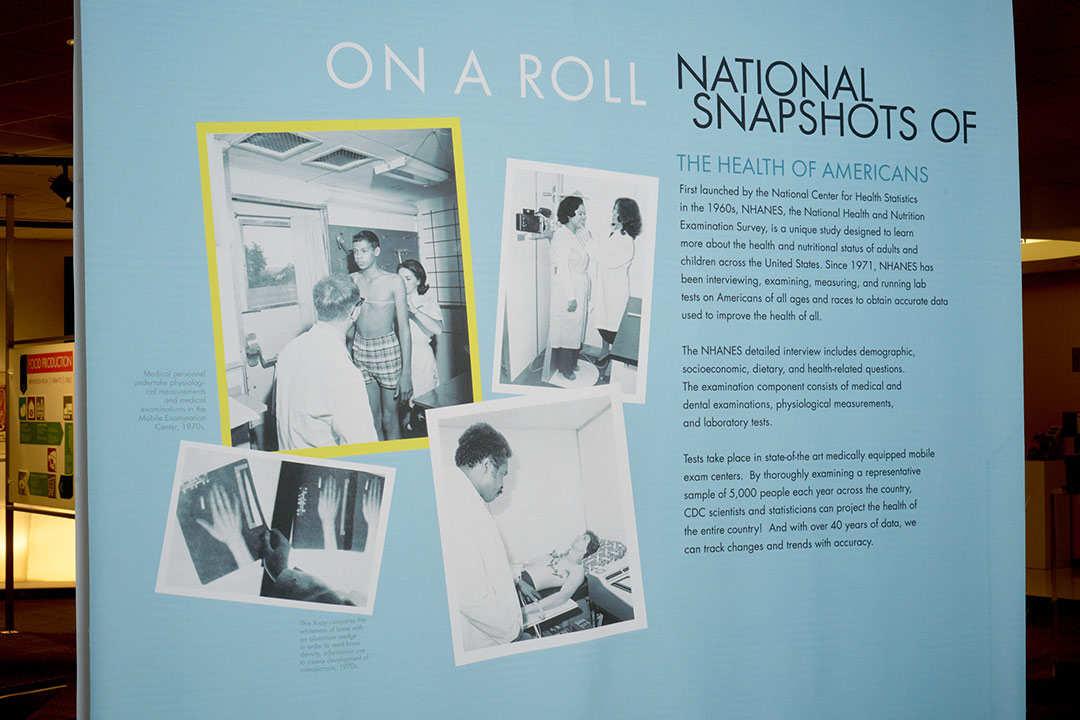
On-A-Roll: NHANES – National Snapshots of the Health of Americans
Next, the exhibit displays the National Health and Nutrition Examination Survey, or NHANES. NHANES is a unique study designed to learn more about the health and nutritional status of adults and children across the United States.
The survey started in 1959, but in 1971 switched to the format used today. NHANES collects demographic, socioeconomic, dietary, and health-related information from participants. It also involves participants coming to a mobile lab center to receive an extensive array of tests. As the photos show, participants undergo physiological measurements, laboratory tests, and medical examinations. In the photographs, a teenage boy’s chest is being measured while in another photo, a different young man is being monitored by a heart machine. A middle-aged woman stands on a scale, and in the last photograph, health officials are examining X-rays of a hand and wrist.
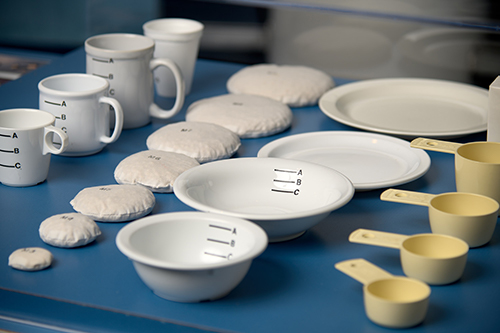
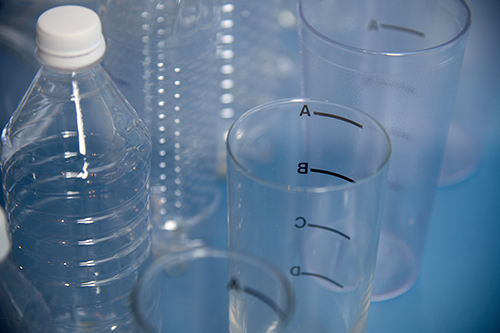
Just How Much?
Seen here are different sized plates, bowls, cups, spoons, water bottles, milk cartons, coffee containers, and measuring devices. These objects are used by participants to help estimate what they eat and drink in the nutrition portion of the survey.

Decades of Data
By using the highly accurate data obtained during the survey, CDC scientists and statisticians can project the health of the entire country. Decades worth of data allows CDC to track changes and trends with accuracy and help improve the health of all. The image above depicts samples from the 1988-94 surveys in which nearly 34,000 Americans participated. NHANES continues today.

MMWR: The Scientific Voice of CDC
Communication is an important component of any public health program. Today, CDC dispenses information in a variety of ways, and the Morbidity and Mortality Weekly Report, or MMWR, has been a big part of the agency’s communication.
Historic objects chronicling the origins of this long-running publication are shown here. Originally, the federal government worked with state health departments to track specific “notifiable” infectious diseases such as influenza, hepatitis, and syphilis. In 1961, the National Office of Vital Statistics was transferred to Atlanta and CDC began to publish the MMWR. Public health scientists, the media, and average citizens rely on the MMWR as a major source for late-breaking health news. The MMWR and its online publication have never missed their weekly Thursday publication deadline.

Historic Ledgers
An enlarged reproduction of the first page from CDC’s first MMWR that was published on January 13, 1961 is shown here, along with rectangular paper ledgers from the 1950s through 1960s and an early edition from 1960. These ledgers show how data for the MMWR were collected. Ledger sheets were used from the 1950s through the 1960s to collect public health information from across the country. The top sheet on the stack displayed here dates to 1954, and shows data collected from the state of Texas. The first column lists the notifiable diseases at that time. Notifiable diseases are diseases doctors and hospitals are required to report to health departments. The next twelve columns are labeled by month and provide the number of cases for each one. The last column is labeled “final figures,” and tallies up the number of cases per disease. The ledger page has long, thin, strips of paper with corrections written or typed and attached to it. The stack is very high and likely contains data from all fifty states that cover many years. Luckily, today’s public health data is electronically compiled quickly and accurately through public health surveillance systems.

Know Your Cholesterol: Cholesterol Standardization Program
Next, the exhibit explores four examples of innovations from CDC: cholesterol testing, antibody testing, air quality monitoring, and insect specimen sampling.

CDC’s Cholesterol Reference Method
In the 1950s, scientists realized that measuring cholesterol could predict heart disease. They disagreed, however, about which measurements to use. By 1957, CDC developed accurate cholesterol measurements, leading to the establishment of the Cholesterol Standardization Program. This program provides services to researchers and labs, ensuring cholesterol numbers around the world are accurate. A booklet, printed on metal, provides a step-by-step presentation of CDC’s Cholesterol Reference Method used in the process to measure cholesterol.

What Glows in the Dark: Fluorescent Antibodies
Next, the exhibit showcases “What Glows in the Dark: Fluorescent Antibodies.” Six brightly colored images of cellular pieces in spots, clouds, and string-like shapes are examples of fluorescent antibody testing, a technique developed by CDC scientists in the mid-1950s to aid in disease diagnosis. Before this technique was available, identifying a patient’s illness could take days. A doctor or nurse collected a specimen, sent it to a lab where a microbiologist would take hours or days to isolate, culture, and identify the organism responsible for the illness. With the fluorescent dye technique, antibodies could be detected within minutes, helping doctors provide faster treatment to their patients. Antibody testing remains a widely used diagnostic today.

Tools to Investigate Workplace Health Hazards
The third innovation featured in the exhibit is a device for measuring air quality. Seen here is a device developed by National Institute for Occupational Safety and Health, or NIOSH, for collecting air samples. NIOSH joined CDC in 1973 with a mission to prevent occupational diseases and injuries. In the course of its investigations, NIOSH has developed various devices and tools to take samples and measurements from the workplace environment.
NIOSH investigated overexposure to solvent vapors at the General Electric Company facility that manufactured ballasts for fluorescent lighting fixtures in Madisonville, Kentucky. To collect air samples in order to measure the vapors, NIOSH developed portable air sampler pumps and glass sampling tools containing charcoal. The air sampling pumps, which are brick-sized, were rectangular metal boxes that employees wore at their waists instead of being placed on the walls of the manufacturing plant. In addition, employees wore the glass sampling tubes fastened at their shirt collars to collect the air that they were breathing. NIOSH determined that the solvents used in the manufacturing plant were above the acceptable range and made recommendations for reducing the employees’ exposure to harmful solvent vapors.

Trapping Mosquitoes: CDC Light Trap
The final innovation example on display is the CDC Light Trap, a mosquito trap designed by CDC scientists in the 1960s. Entomologists who study viruses carried by mosquitoes need practical and convenient methods to capture the vectors in the field to study the viruses and parasites they carry. Built and refined in CDC’s equipment development shop and still in use today all over the world, this light trap has been instrumental in tracking down mosquitoes that cause diseases such as encephalitis and West Nile fever.
The trap on display hangs about five feet off the ground. When in use in the field, the trap hangs in a tree. At the top of the trap is an opening for mosquitos to enter, the trap’s light source, a grid on which to place dry ice, and a battery-operated fan that blows down into the lower net. In the field, a scientist could place dry ice at the top of the trap as bait for the mosquitoes. Dry ice releases carbon dioxide, which attracts the insects. Mosquitoes fly near the dry ice and are swept down into the net below by the current created by the fan. Mosquitoes are not able to fly against wind current, and therefore are trapped in the larger sealed net below. Nets like these allow field scientists to gather information about the pathogens in mosquito populations

New Responsibilities Bring New Challenges
During the late 1970s, diseases like Lassa fever, toxic shock syndrome, Legionnaires’ disease, and Ebola emerged very suddenly. An emerging infectious disease is defined as one whose incidence in humans has increased in the past two decades or threatens to increase in the near future. These new diseases may be the result of pathogenic organisms evolving, ecological changes, infections spreading to new populations, antimicrobial resistance, or breakdowns in public health measures. As new infectious diseases posed new threats to the public’s health, CDC faced new demands and new responsibilities.

CDC Collaborates with NASA: Moon Mission Quarantine
CDC’s awareness of the potential of new diseases existed before the 1970s, though, as shown in CDC’s involvement with the space program. Concern that a spacecraft might bring back extraterrestrial pathogens or take Earth-borne pathogens into space resulted in CDC being consulted by NASA. CDC helped make sure spacecrafts traveling to the moon or Mars were germ-free, and assisted NASA by adapting a trailer to create the Mobile Quarantine Facility, which was used by the 1969 Apollo 11 moon mission. A photograph seen here shows then-President Nixon visiting the Apollo 11 crew while they were in quarantine. Another photo shows NASA using a large aircraft to transfer the refurbished mobile isolation unit to CDC for use in case a team member became ill during the first Ebola virus outbreak in 1976. While no new diseases came from outer space, the next decade proved challenging as new diseases emerged on Earth.